Repurpose Items Creating More Value
Content Marketing offers a tremendous opportunity for businesses to boost their results. By delivering valuable and relevant content to users, you can improve your online reputation, build a community and grow advocates of your brand.
These statistics prove the effectiveness of Content Marketing as a powerful approach for growing online visibility:
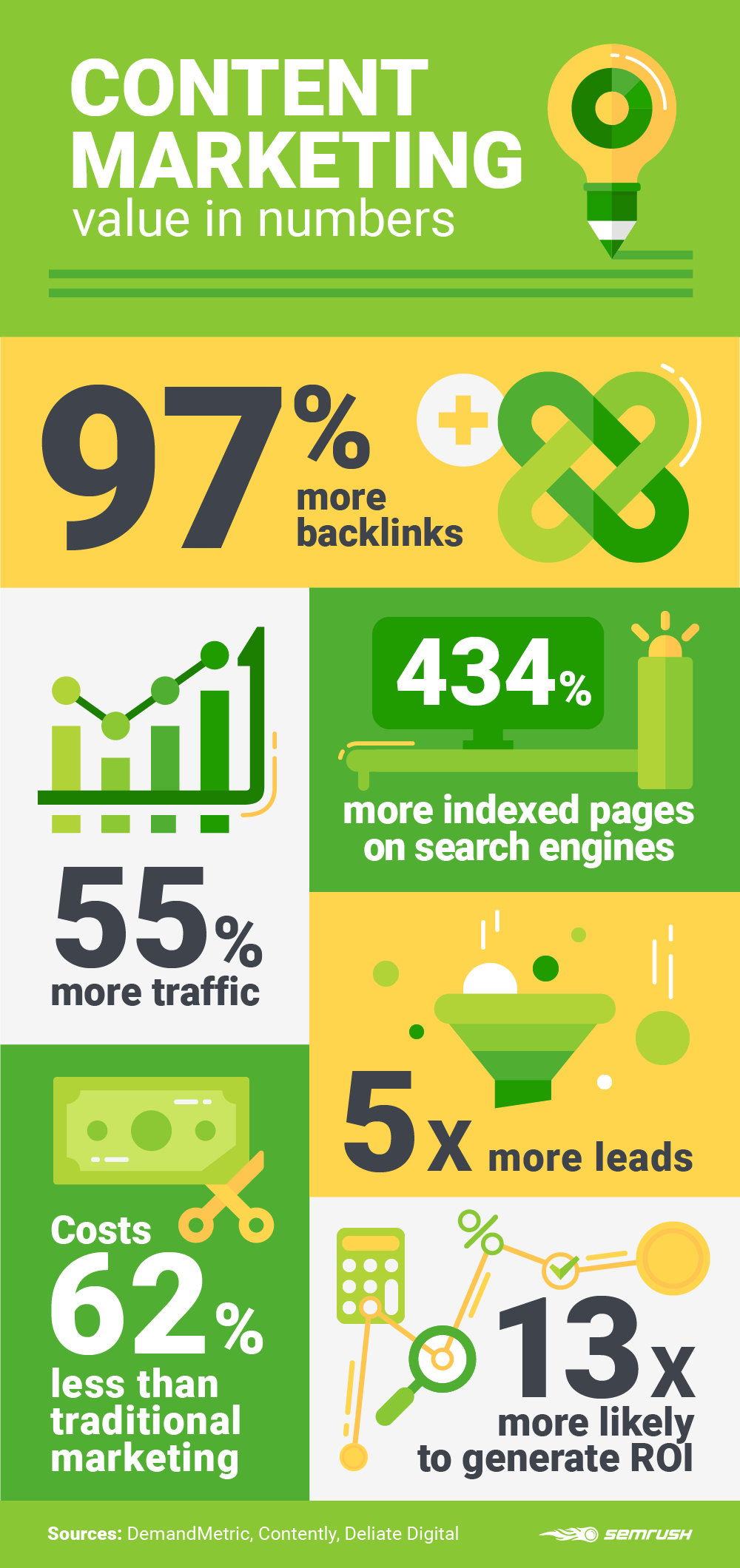
SEMrush Content Platform
Empower Your Content Strategy with Data

However, Content Marketing is not just creating and distributing content. It is an entire strategic approach to content mapping that allows you to attract and engage a clearly defined audience and, ultimately, generate profitable customer action.
By following the guide below, you will have the in-depth information needed to develop a great Content Marketing strategy for your business.
The Four Elements of a Content Marketing Strategy
An effective Content Marketing strategy must have four core elements to be successful: brand positioning, owned media value proposition, business case, and strategic plan. Let's see why these elements are essential for Content Marketing and how you can start implementing each of them.
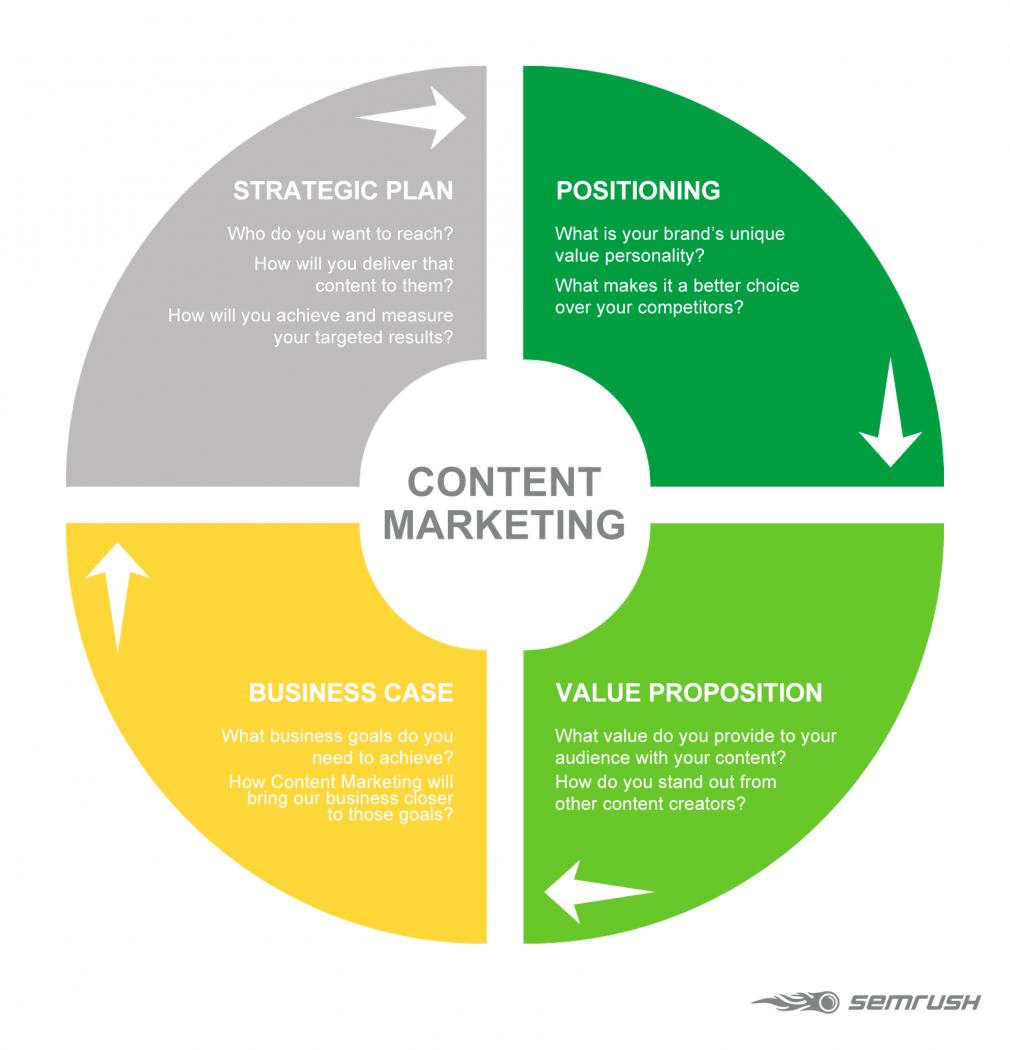
1. Positioning Your Brand
A clearly defined brand and product positioning will help you to provide a consistent experience for your audience and to build the right image of your brand through all your Content Marketing channels.
The following questions will help you start brainstorming about your position in the market:
-
Who are my existing and potential customers?
-
What kind of experience are they looking for?
-
What is the competitive landscape?
-
How do my top competitors market their brands?
-
What is my brand's unique value?
-
What problems does my product help to solve?
-
What makes it a better choice over my competitors?
-
How can I highlight my brand's personality?
2. Owned Media Value Proposition
To establish your brand as a credible content publisher, you need to define your owned media value proposition. What unique value do you provide to your audience with your content? How do you stand out from other content creators? Why should readers choose to follow your content channels?
Start researching your audience to identify the type of information they are looking for and their favorite resources. Then, analyze your competitors' content strategies to find your editorial niche.
Too often, brands are focusing on their market rivals and don't pay enough attention to other content creators. Once you decide to develop owned media, you should consider all publishers in your area of expertise as potential competitors. So, make sure that unbranded media, like online magazines, industry blogs or influencers' video channels, are a part of your competitive research.
3. Business Case
Providing value to your audience is an integral part of a successful content strategy. But in addition to attracting new readers and followers, Content Marketing should drive your business forward.
Identify business goals that your company needs to achieve and figure out how Content Marketing will bring your business closer to those goals. How many resources do you need to invest in your content strategy and what results do you want to get from this?
A documented business case will help you better understand the benefits, costs, and risks of implementing a Content Marketing strategy in your company and convince decision makers of its value for the company.
4. Strategic Plan
A strategic plan should focus on your goals and how exactly you will achieve them. It will help you to think through each step of your content strategy. This plan should help you decide who you want to reach with your Content Marketing efforts, how you will deliver that content to them and, finally, how you will achieve and measure your targeted results.
Now let's see how you can develop a perfect content strategy plan with some useful tips and tools that will help you to be more efficient.
Seven Steps to Creating a Complete Content Strategy Plan
Long-term planning allows you to focus on your company's goals, anticipate challenges and allocate resources effectively. Laying out these seven steps will help you to develop and implement a complete content strategy plan step by step.
Step 1: Audit Your Existing Content
A content audit can help you to stand out in an era of mass content production. Considering there are approximately 1.6 billion websites and more than 70 million blog posts published each month, there is an unfathomable amount of information for your audience to click on. Creating content with no understanding of what works for your audience and your brand is a waste of time and resources.
Collect all your existing content and analyze data sets to understand the actual state of your content. What kind of content attracts your audience? What content brings you the best results? What do you need to improve?
Check out our article " How to Perform a Website Content Audit to Guide Your Content Marketing Strategy" to get a step-by-step guide to content auditing.

Explore the List of 2021's Top 26 Content Marketing Examples to Get Inspired
Step 2: Establish your content marketing goals
To keep your goals clear, ensure that every content piece builds toward meeting those goals and organizes them in a hierarchical fashion. Start with goals related to your overall vision and mission before moving on to identifying long- and short-term goals your Content Marketing can help accomplish. Long-term strategic goals should take precedence over specific operational goals in your plan.
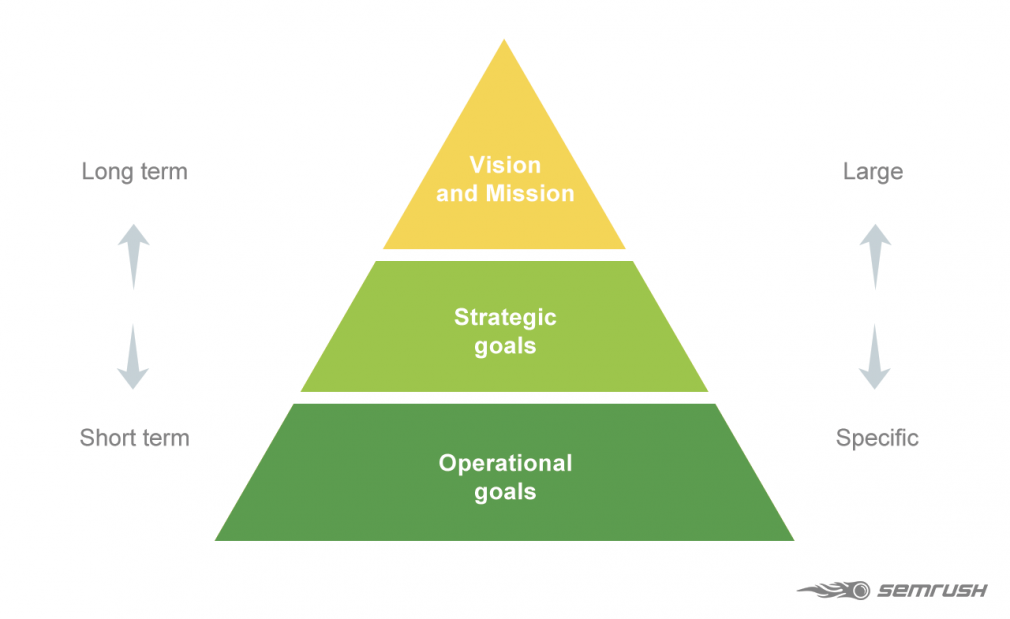
Don't forget that your Content Marketing goals should contribute to the achievement of your business goals and be linked to the global marketing strategy of your company.
Goal-Setting Frameworks
While you may be more comfortable with traditional goal-setting frameworks like SMART (Specific, Measurable, Achievable, Relevant, and Time-Bound) goals, flexibility is key to setting realistic benchmarks. Consider using the framework CLEAR, which can help you to be more agile in a fast-changing environment.
Your CLEAR objectives are evaluated in terms of their main characteristics:
-
Collaborative: your goals encourage teamwork.
-
Limited: they are limited in scope and duration.
-
Emotional: they inspire and motivate your team.
-
Appreciable: they are broken down into smaller micro-objectives.
-
Refinable: they can be redefined according to circumstances and needs.
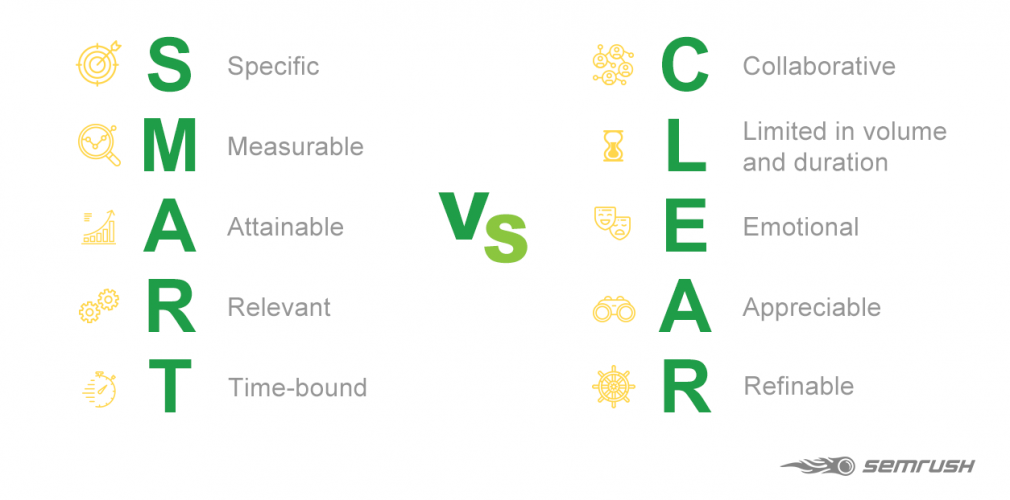
If you find KPIs (Key Performance Indicators) to be too technical or limited in scope, you can set OKRs (Objectives and Key Results) to make your goals more flexible:
-
Set each goal as a challenge.
-
Define 3-4 key results by objective.
-
Measure your goals with a progress indicator of 0 to 100%.
-
Make your goals collaborative and transparent.
-
Assess goals according to new conditions.
-
Adjust a goal if it becomes irrelevant (even if you didn't anticipate it).
With this approach, you can target an ambitious result, but set a minimum threshold for reaching the goal. Progress indicators (0%-100%) allow each team member to see how attainable each goal is, as well as understand what remains to be done.
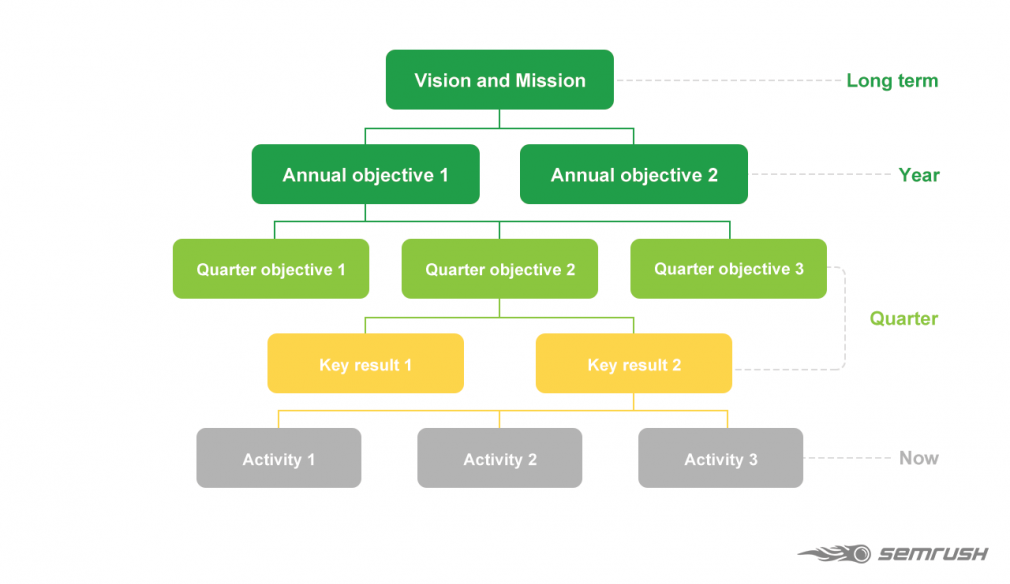
In contrast to KPIs, which can be reset only for each new quarter, objectives in OKRs can be updated at any time if initial conditions change. With OKRs, you will not waste your time working on goals that are no longer relevant to you.
Step 3: Determine Your Audience
Finding your audience and drawing them in with your content pieces is the key to success in Content Marketing. To do this, you have to understand their lifestyle, concerns, problems, and needs.
Audience ≠ Buyers
Creating buyer personas is very important for Content Marketing, but your audience isn't solely made up of buyers. Audiences include people who begin interacting with your brand long before they intend to make a purchase.
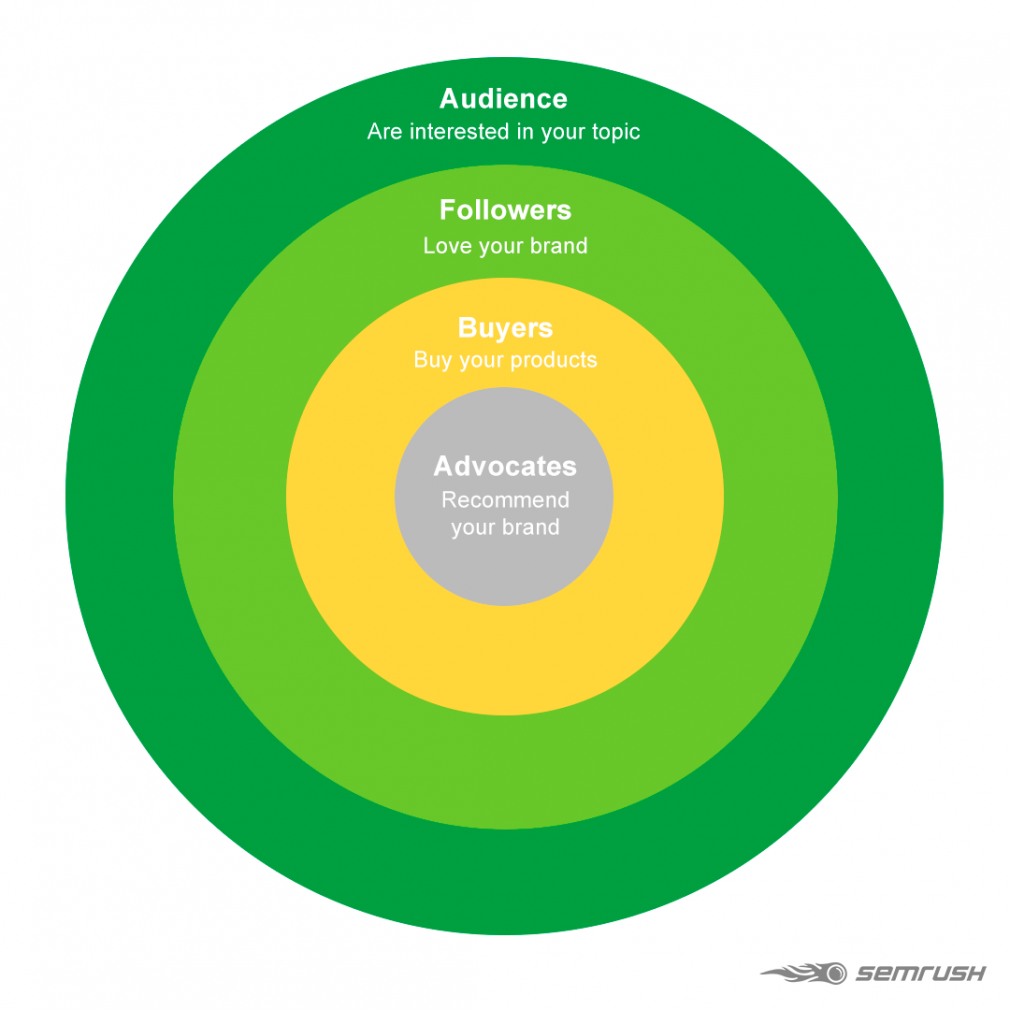
It is essential to deliver content that will attract your potential customers before they enter the buyer's journey and draw them into the universe your brand has created. Then, follow up with content that illuminates how your brand can be of assistance when they are ready to take action.
Red Bull is an excellent example of a brand that creates content for audiences, not buyers. Red Bull's owned media doesn't focus on its product; it covers topics the audience is interested in, like extreme sports and once in a lifetime experiences. You can easily identify the target audience — young and adventurous people, passionate about sport and an active lifestyle. These offerings help consumers identify with the brand and encourage loyalty that stretches far beyond buying the drinks.
Check out the Last Call for Mr. Paul, the top-viewed video created by Red Bull (it now has more than 100 million views), which illustrates their approach to content marketing.

Red Bull is a media company that happens to sell energy drinks.
The Empathy Map
The empathy map is a collaborative tool that can help you understand your target audience better. This method was described by Alexander Osterwalder and Yves Pigneur in their book Business Model Generation.
The empathy map is based on a comprehensive approach: by adopting your customers' perspective or point of view, you can step back and improve their experience based on what they think, feel, see or hear.
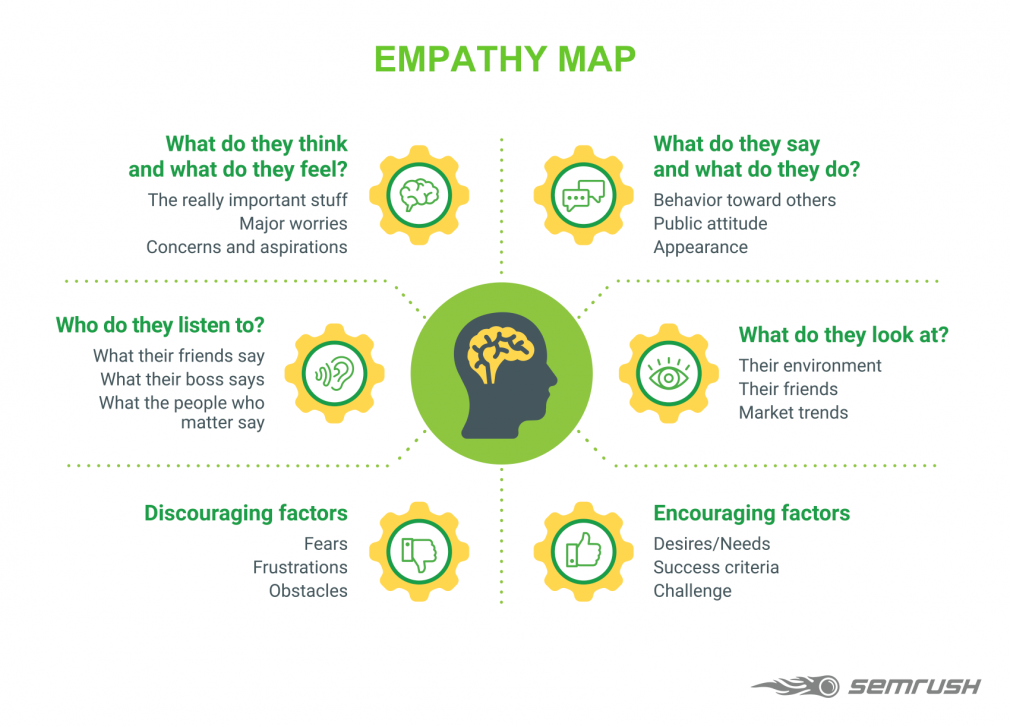
The "Jobs to Be Done" Framework
The "Jobs to Be Done" framework is an easy way to understand your customer's needs and to find the reason they use your product. The idea is to place yourself in the prospect's shoes and try to identify the jobs your customer is trying to get done (what your customer seeks to accomplish in a given circumstance).
As the prospect, try to complete the following sentence:
When I ___ , that's why I want ___ , so I can ___ .
-
'When I___' is the problem of your potential customer.
-
'That's why I want ___' is the solution you can offer to him/her.
-
'So I can ___' is the prospect's need (a state or a result he/she wants to achieve).
For example: When I work, I spend too much time completing all my tasks, that's why I want to find a tool to improve my time management, so I can spend more time with my family.
In this example, "a tool to improve time management" is what you sell, and "more time with family" is what the customer buys.
Keep in mind that your prospects don't need your product as such; they are looking to improve their personal or professional lives by solving their problems.
People don't want to buy a quarter-inch drill, they want a quarter-inch hole.
— Theodore Levitt
Once you have an understanding of the prospect's current problem, the solution they need, and the result they envision, you can create compelling content that can transform them from newcomers into your brand advocates.
Download a free customizable template to enhance your strategy with a competitive content analysis
Step 4: Develop An Editorial Plan
Planning your content allows you to allocate your resources appropriately, and to see which workflows are taking longer than expected, and adjust your expectations accordingly.
Prioritize Your Actions
One of the essential elements of efficient planning is prioritization. If you plan your actions, you can identify the most critical tasks that you should do or things that you can easily test. By doing this, you can protect your strategy from major fails and find opportunities for experiments that can potentially boost your results.
Find Relevant Topics
To start, you will need to uncover the topics that attract your audience's interest as they progress through the customer journey. The Topic Research tool gives you ideas for subjects you should cover, as well as related questions, possible subtopics, and headers. You might focus on creating evergreen content, building topic clusters, or leveraging newsjacking - it'll suggest ideas for either of those strategies.
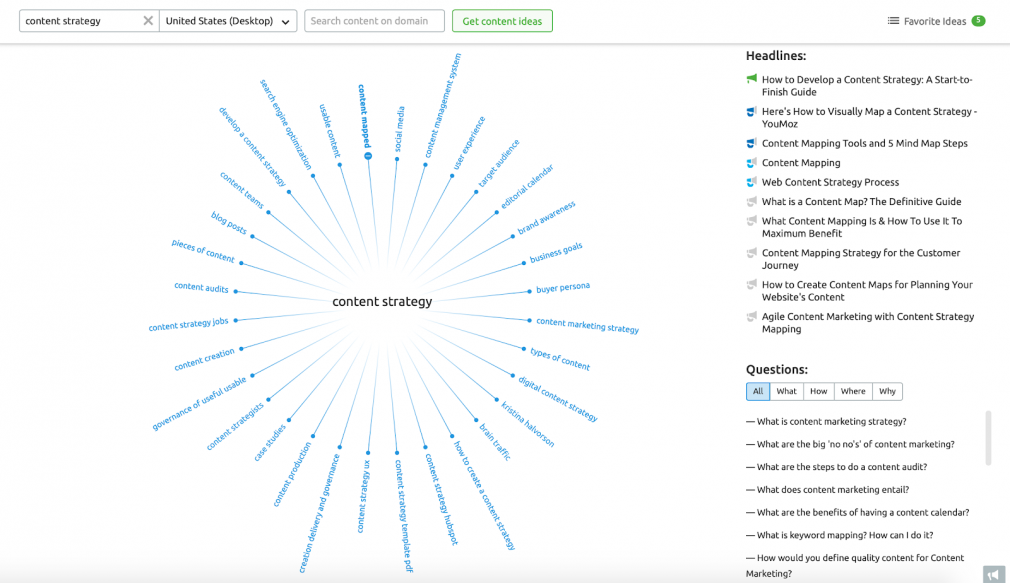
Once you have determined the right topics to include and the appropriate format for the content pieces, you can place them on a content calendar to make it easier to track upcoming and missed deadlines.
Learn More about Building High-Performing Content Hubs
Use an Editorial Calendar to Organize Your Work
The SEMrush Marketing Calendar tool works as an editorial calendar that allows you to monitor progress and streamline communication across multiple team members as you create, publish, and analyze content.
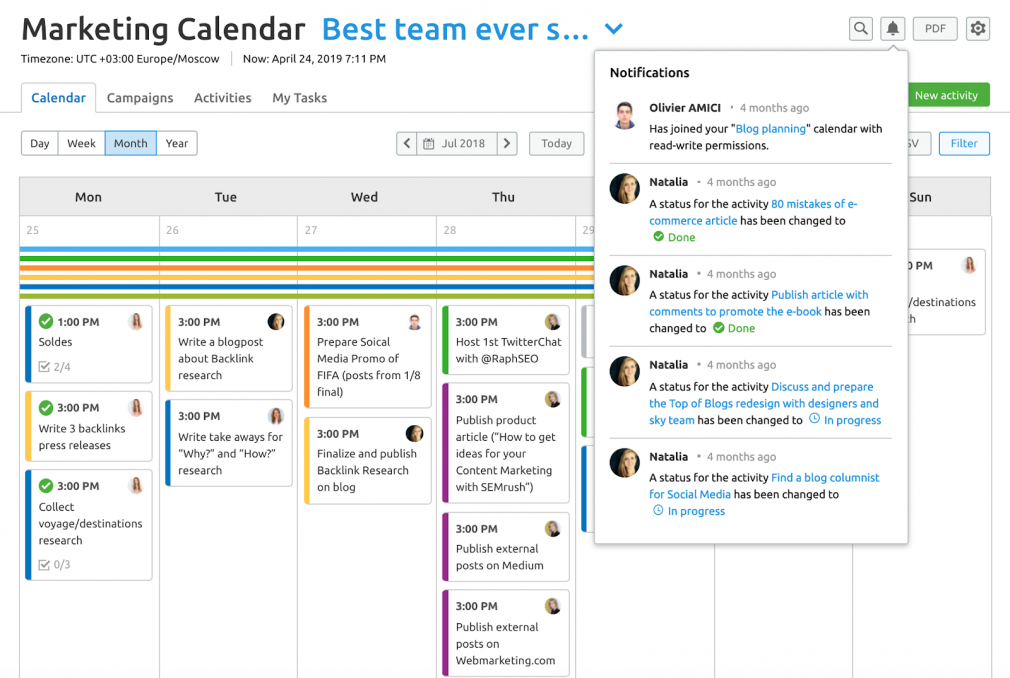
You can add tasks, assign them to specific people, and set deadlines — all while collaborating with unlimited team members. This tool will help you cut down on the amount of back-and-forth email communication you receive about projects while keeping everyone involved via a notification system.
Step 5: Plan Content Production
Before starting the content creation process, think about the purpose of each piece you want to create. Make sure that your content covers every part of the customer journey to support your prospects at each stage, and, ultimately, develop a long-term relationship between your client and your brand.
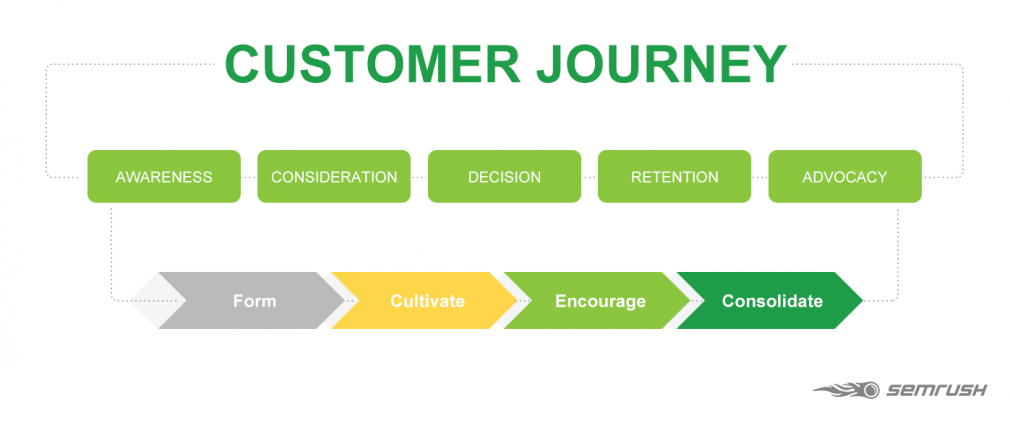
-
Awareness Stage – These pieces are often centered around questions your leads may have at the top of the funnel as they become more aware of their problem or need; this can also be content that tells your brand story, educates, informs or entertains your audience. Thought leadership content works great at this stage.
-
Consideration Stage – As they progress through the consideration stage, prospects will want to know more. Help them understand why they need assistance in overcoming the issue in front of them; guide them through how others have solved similar problems in the past; and discuss what steps may be necessary to follow up.
-
Decision Stage – These pieces are designed to help potential leads determine why you are the best choice to help them. Case studies, client reviews, and specific analysis of the work you have done in the past can be helpful at this stage, as users compare you directly with other providers.
-
Retention Stage – Bring to the forefront the various ways to get the most out of your product or service, as well as ways to solve common issues, and new features. Anticipating the questions they will ask and addressing them preemptively can also keep prospects from growing frustrated with your offerings.
-
Advocacy Stage – These are pieces that highlight the parts of your brand that will transform customers into evangelists; this might include pieces that spotlight your corporate values, efforts to give back, or outstanding team members.
Explore the Definitive Guide to Content Marketing for Startups
Diversify Your Content
Include a diverse mix of content types in your plan to appeal to every member of your audience.
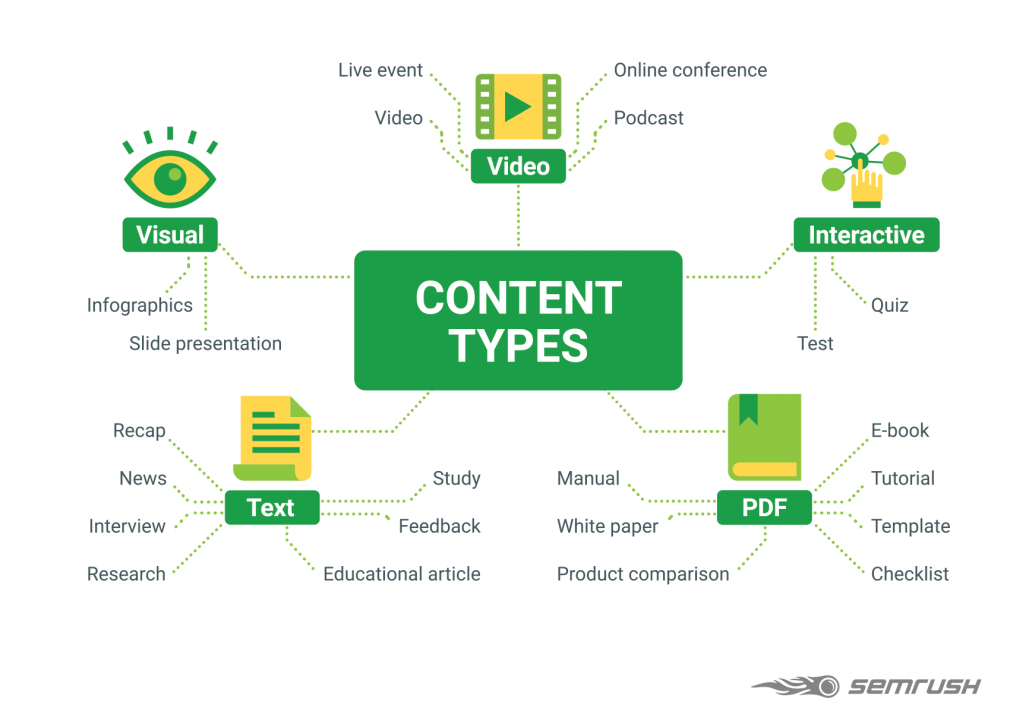
If you have limited resources for content creation, here are three tips that can help you to be more productive:
Create SEO-Friendly Content
35% of all website traffic comes from organic search; this is why search engine optimization is essential for creating any piece of content. Once your content is created, you can use the SEMrush SEO Writing Assistant to ensure that articles are optimized for organic search.
Discover the 2021 Guide to Content Optimization
It's also important to ensure your copy is engaging: focus on keeping a good readability score, maintaining a consistent tone of voice, and making your content structure skimmable.
Repurpose Your Content
Once a content piece is published, you can repurpose it to appeal to new readers who may prefer a different format. Easy ways to repurpose an existing content piece include:
-
Turn an article into an infographic, slideshow, or video.
-
Segment a long article or video into shorter pieces that you can publish as a series.
-
Combine short content pieces to create a white paper or a long-read article.
-
Create slide presentations.
-
Create usable snippets and informative images for social media.
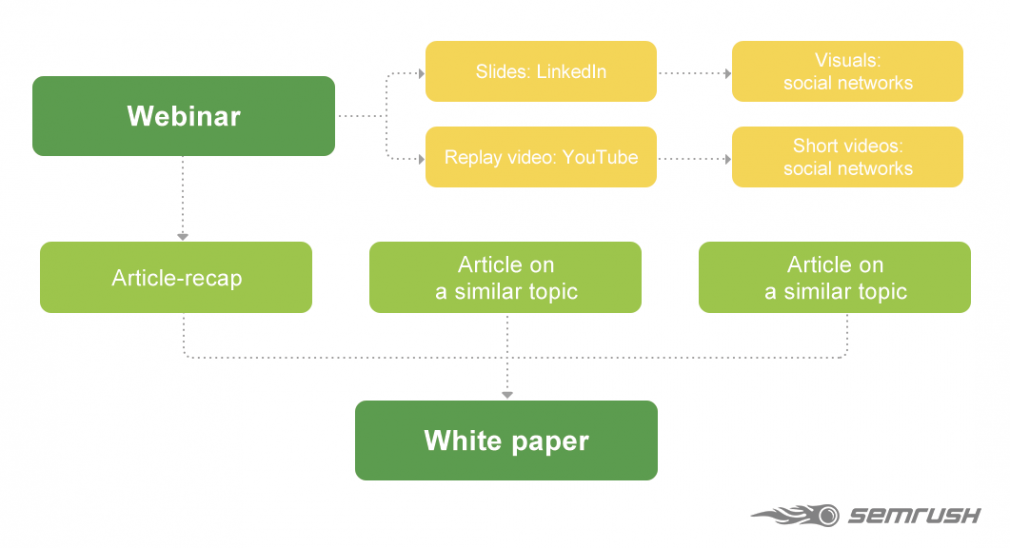
Take Advantage of User-Generated Content
Include user-generated content in your narrative to help grow your reputation with your audience. Reviews, comments, photos, and videos help add legitimacy to your claims. Plus, gathering and sharing this content can be easy and save you plenty of resources.
Try the SEMrush Brand Monitoring Tool to find user-generated content by analyzing mentions of your brand, products or services. You can also plug in a competitor's information to get an idea of how well they are doing compared to you.
Explore the Ultimate 2021 Guide to Content Development
Step 6: Plan Content Distribution
We have already mentioned that one of the core elements of Content Marketing is owned media development. Earned media and paid media, in their turn, represent essential elements of a content distribution strategy.
You can see below how owned, earned and paid media can work together:
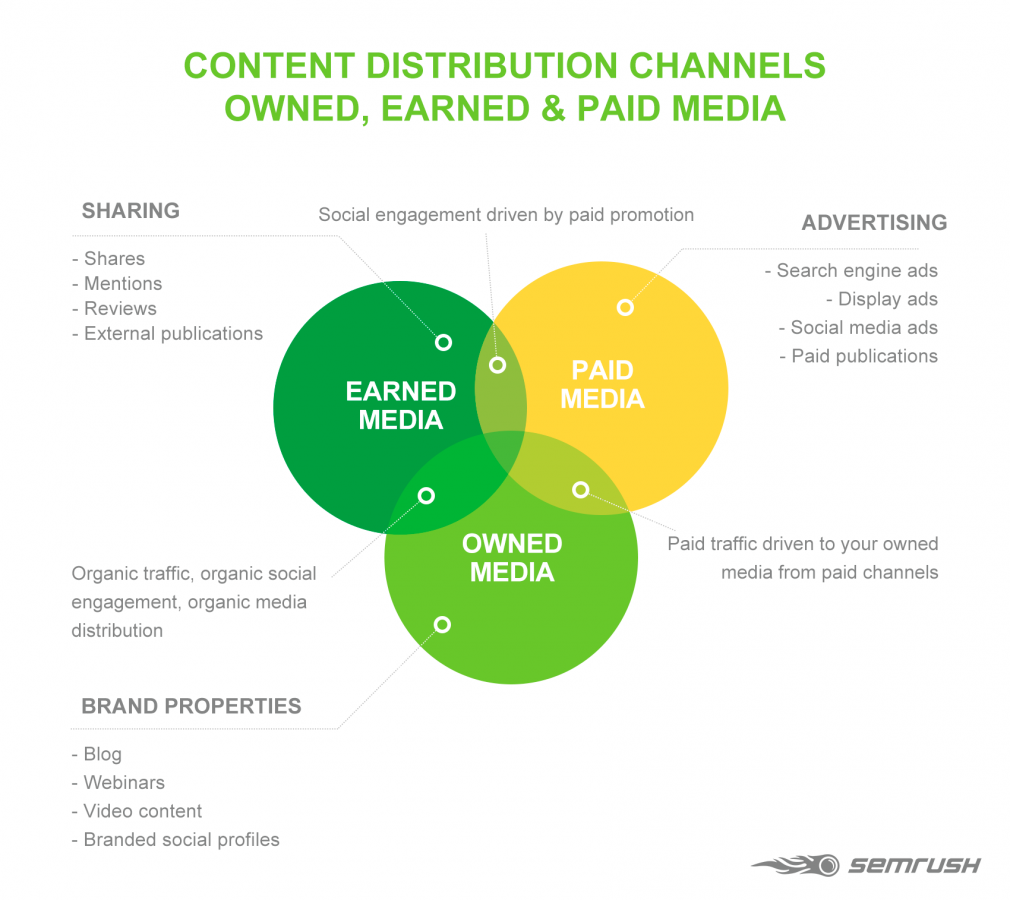
Create an Integrated Omnichannel Experience
Providing omnichannel communication to your audience is the best way to help keep your brand at the forefront of their minds. By aligning the brand messaging and goals across multiple channels, your audience will get a clear picture of who you are and what you can offer.
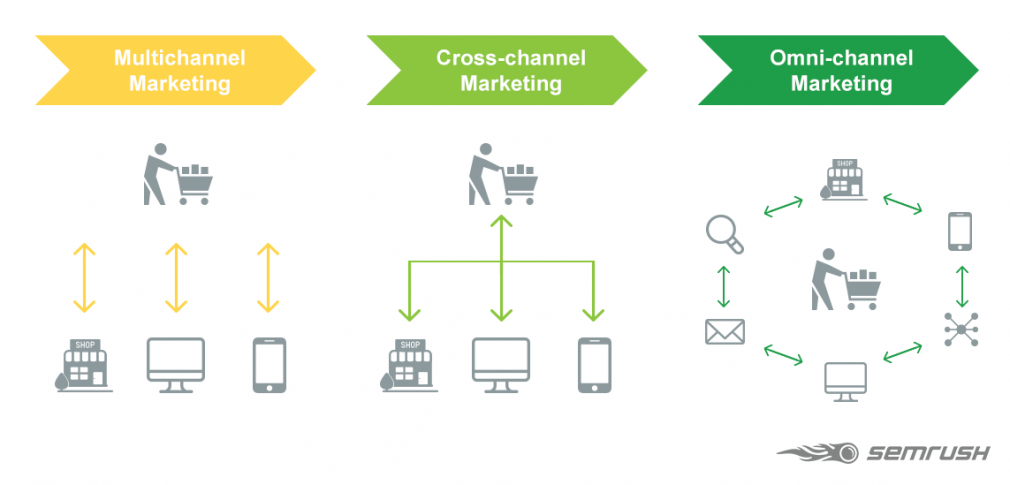
Identify the Most Relevant Channels
Resources should go to the channels where your audience already spends most of their time to give your content the best chance of being seen. Specific social media analytics and demographics can determine which channels to try to engage your clients or target audience, and which ones may be a waste of budget. For example:
-
Pinterest can distribute visual content pieces like infographics, schemas or original illustrations, and attract traffic to your website.
-
Instagram is a great place to tell a visual story that develops your brand's identity. It is particularly relevant for B2C, especially for areas like beauty, lifestyle, travel, etc.
-
Snapchat has a younger presence, making it a key channel for brands that market to millennials and tweens, but it is less important for those who want to reach the older demographics — Generation X or Baby-boomers.
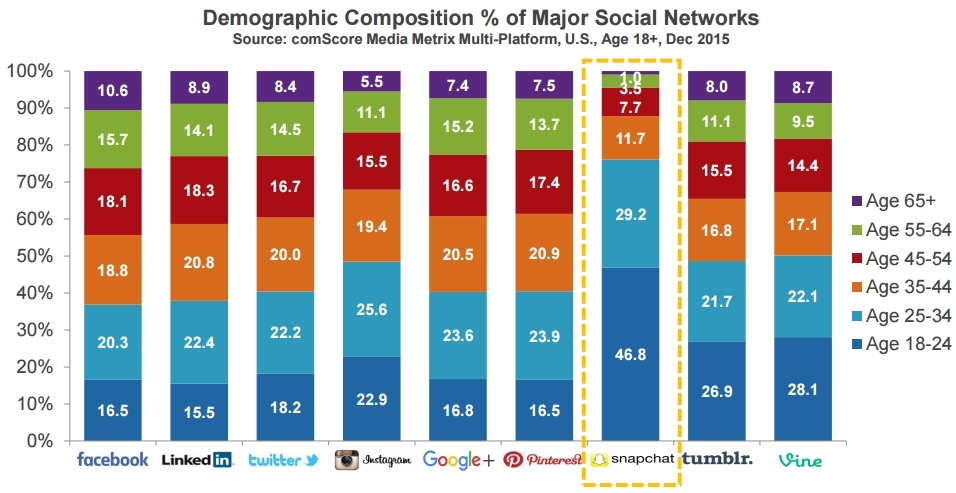
Using the research you have already compiled, you can determine where your audience is most likely to see and consume your content.
There are also multiple content promotion formats you can get creative with: from influencer-driven thought leadership content, to sponsored content, lead-generating content ads, viral concepts, and more.
Creating a seamless user experience on different social media channels can seem time-consuming, but it doesn't have to be. You can easily automate posting to multiple social media networks to save resources and ensure accuracy in timing.
Schedule social media posts ahead of time with the SEMrush Social Media Poster and check which ones are getting the most engagement from followers.
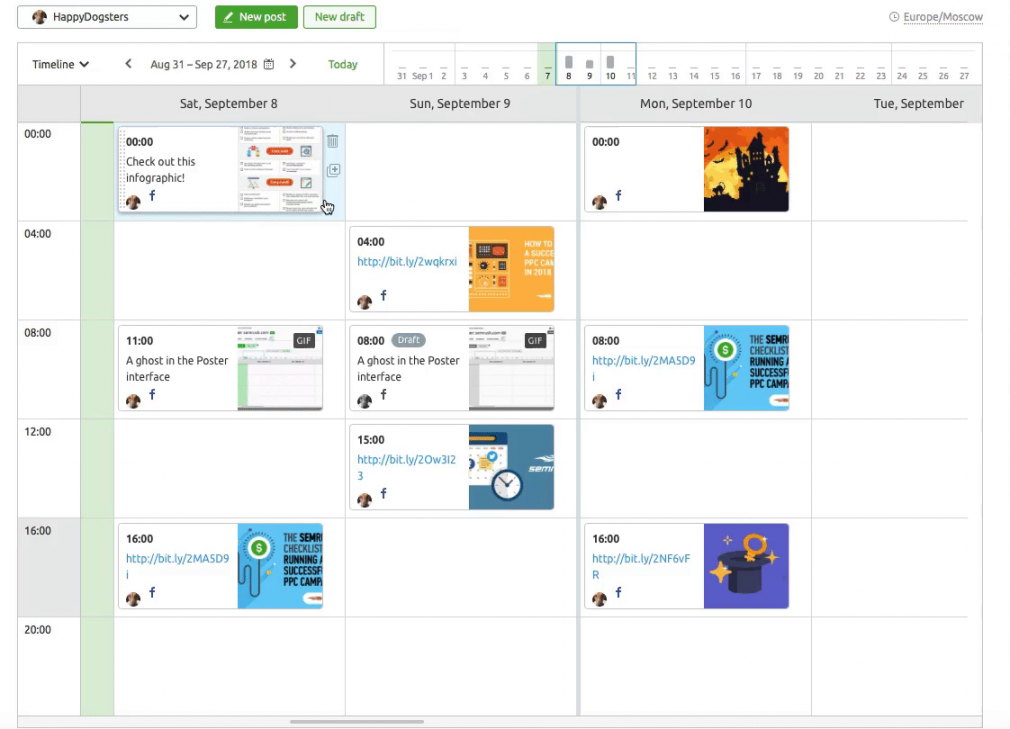
GIF
Step 7: Analyze Your Content Performance
Analyzing your content performance is the best way to understand what type of content is connecting with your audience, and then determine what pieces to generate next. Your audience will give you clear signals about what attracts their interest the most, making it easier for you to come up with new content that intrigues them.
Content metrics fall into four categories:
-
User behavior: unique visitors, pages per session, bounce rate.
-
Engagement: likes, shares, comments, mentions.
-
SEO results: organic traffic, dwell time, backlinks.
-
Company revenue: number of leads, existing leads affected, conversion rate.
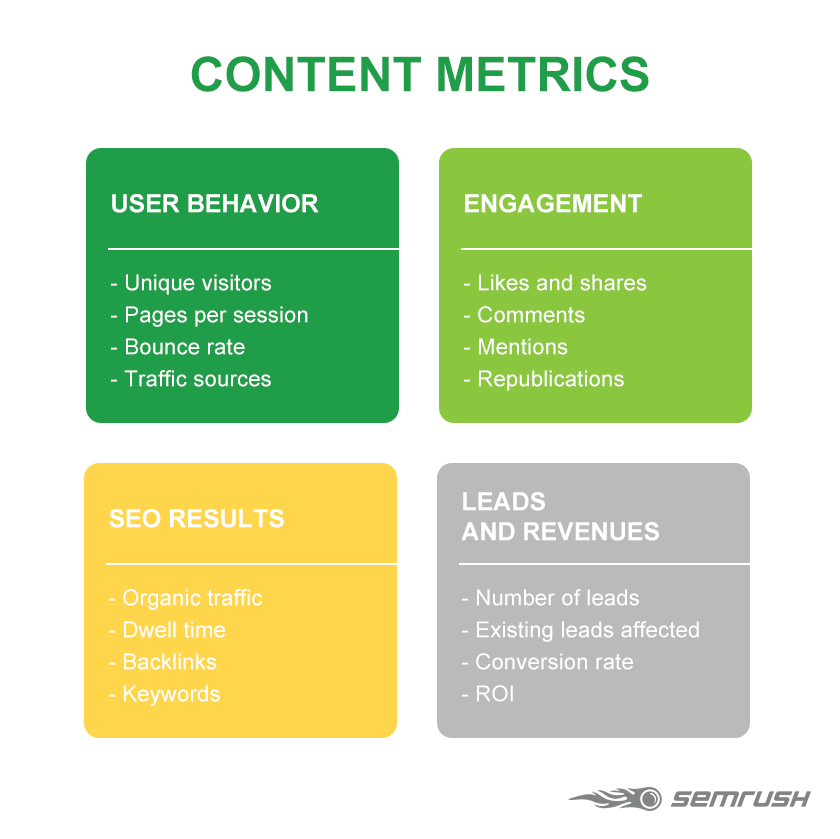
Our post " 4 Essential Groups Metrics to Measure Your Content Marketing Performance" will help you better understand each of these categories and provide you with different ways to measure your key metrics.
SEMrush tools can also help analyze which content offerings are connecting with your audience and figure out what the next content piece should focus on. Our Content Marketing Platform offers unique tools, such as:
-
Content Audit, which analyzes your existing content and segments it into groups.
-
Post Tracking, which helps track the reach of articles you or a competitor has already published.
For a deeper analysis, use ImpactHero, a smart content analytics tool that helps you to inspect your entire content funnel and prove the effectiveness of your content strategy. The tool breaks down your content by buyer journey stages, detects the most impactful copy, and gives practical tips on improving your efforts.
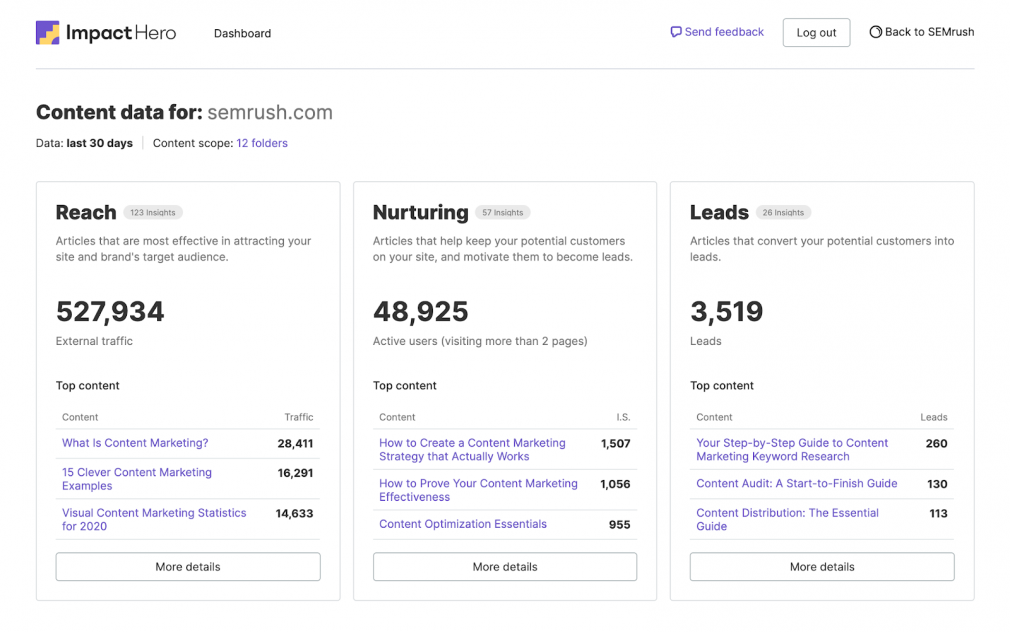
We have developed ImpactHero specifically for content marketing teams and based on their needs and feedback. Using the tool, you can:
-
Analyze and measure your content funnel performance by stages;
-
Discover the impact of specific pieces of content on conversion;
-
Learn what kind of content attracts your target audience;
-
Get performance-driven tips on improving underperforming pieces.
Explore 7 Ways to Use Semrush for Content Marketing You Probably Didn't Know About
In Conclusion
While the methods used to deliver content to prospects are continually changing, the core principles remain the same — develop a top-notch Content Marketing strategy based on trustworthy data.
As you progress in your Content Marketing efforts, you will find that SEMrush offers tools and blog posts to make a data-driven approach to Content Marketing easier.
SEMrush Content Platform
Empower Your Content Strategy with Data

Repurpose Items Creating More Value
Source: https://www.semrush.com/blog/content-marketing-strategy-guide/
Posted by: rodriguezquakfank.blogspot.com

0 Response to "Repurpose Items Creating More Value"
Post a Comment